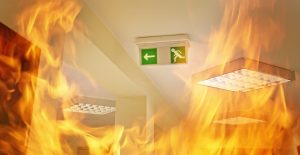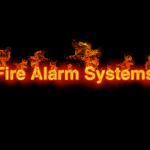In an ideal world, a building would never catch fire, and businesses would operate without worry for safety or damages. Unfortunately, fires are a real risk, and it’s up to the company owner to ensure that workers and customers are protected inside one of their buildings. Implementing fire stopping techniques is one of the essential methods of preventing the spread of fire in a building, reducing the potential loss of life and property.
A professional fire stopping survey can help you develop a fire stopping strategy for the future or it can help locate damaged areas in an existing fire stopping system.
Contents
What Is the Purpose of a Fire Stopping Survey?
 A fire stopping survey is an inspection and report that will determine areas where fire-resisting walls and ceilings have been breached, so the correct remedial works can be carried out to stop the spread of fire and smoke throughout a building.
A fire stopping survey is an inspection and report that will determine areas where fire-resisting walls and ceilings have been breached, so the correct remedial works can be carried out to stop the spread of fire and smoke throughout a building.
What Is Fire Stopping?
Fire stopping is the sealing of any openings to prevent a fire from passing through multiple building fire compartments. A fire compartment has walls and floors made from fire-resistant materials designed to restrict the spread of heat and flames.
Buildings must ensure that any openings and gaps are fire stopped, so the integrity of the fire-resistant structure isn’t compromised.
What Are Fire Stopping Materials?
The efficiency of the fire compartments is influenced by the materials used. Materials need to be resistant to fire penetration, excessive heat transfer, and collapsing due to nearby structural damage.
Fire stopping materials are used in areas other than the walls and floors of fire compartments as well. For example, the joints between compartments are fire stopped to protect elements like cables and pipes that might run through the area.
The ideal material to use is going to vary according to the task at hand. A few examples of materials include intumescent mastics, glass fibre, ceramic-based products, and cement mortar.
What Are Fire Stopping Products?
The materials we mentioned above are some of the building blocks of fire stopping products that are used in modern buildings. Fire stopping products are often used to seal the joints or opening between walls and floors to prevent the spread of fire. However, these products also need to allow the building to maintain continuity with its internal systems like plumbing, wiring, ducting and rafters.
Fire Collars
 Fire collars greatly increase the fire resistance levels of pipes in the building. They use intumescent materials that will expand during a fire. The expansion prevents the heat, gas, or flames from passing through to adjacent compartments in the building.
Fire collars greatly increase the fire resistance levels of pipes in the building. They use intumescent materials that will expand during a fire. The expansion prevents the heat, gas, or flames from passing through to adjacent compartments in the building.
Fire Covers
A fire cover works similarly to a fire collar but is more often used around lighting fixtures in suspended ceilings. When a fire does happen, the cover goes through an internal expansion process that fills the space with an insulating char that boasts a very high fire resistance.
Fire Sealants and Gap Fillers
There are a variety of different sealants and gap fillers. The chemical properties of the sealants cause them to expand whenever they reach high temperatures. This expansion is what prevents the spread of heat, flames, gas, or smoke through an area.
What Are the Fire Stopping Regulations?
There are legal obligations requiring businesses to install passive fire protection to existing buildings, new builds and residential, or non-residential premises. Requirement 10.2 of the Building Regulations states that fire stopping, or sealing, is applied to joints and openings between fire-separating elements.
Conclusion
Fire stopping surveys are one of the many essential services that our fire engineers offer. They are are well versed with the fire stopping regulations and will ensure your building meets these regulations. We can provide a fire stopping survey where we determine which systems have been breached and what repairs are needed.




